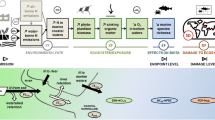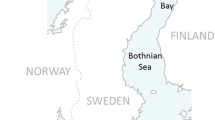Abstract
Purpose
Life Cycle Impact Assessment methodology is still lacking a procedure that relates phosphorus emission to ecological damage in freshwater ecosystems. The aim of this study is to apply new insights in the characterization of aqueous eutrophication at the end-point level. Characterization factors for freshwater eutrophication in European waters caused by emissions of phosphorus to agricultural soils and freshwater were developed. The characterization factors are representative for emissions to the 101 most important European river catchments west of the Ural Mountains.
Methods
We combined site-generic fate factors of total phosphorus, calculated by means of the integrated assessment model CARMEN, with damage factors based on a concentration–response relationship between the concentration of total phosphorus and occurrence of macrofauna species in freshwaters. Environmental fate processes, such as surface run off, groundwater drainage, and hydrological freshwater residence times, are included in the fate factor which relates emission of phosphorus from wastewater treatment plants and due to agricultural supply of manure and fertilizer, to concentrations in freshwater.
Results and discussion
The product of fate factor and damage factor constitutes the characterization factor at the endpoint level with the following results: 1.1·103, 1.2·103, and 2.1·104 disappeared fraction of species·m3·day/kg phosphorus emission for manure, fertilizer, and sewage treatment plants, respectively. Normalization factors are based on the emission of total phosphorus in Europe resulting in 60.1 disappeared fraction of species·m3/person with a relative contribution of 16% by manure application, 18% by fertilizer application, and 66% by sewage treatment plant emissions.
Conclusions
From intervention (P emission) to ecological damage of inland waters, most relevant site-specific processes are included to derive a characterization factor at the damage level. Although the characterisation factor for P due to agricultural application is a factor of 20 lower compared to emissions to freshwater, the nutrient enrichment of European freshwaters is still for one third attributed to agricultural application of phosphorus.



Similar content being viewed by others
References
Berdowski JJM, Jonker WJ (1994) Emission in the Netherlands. Industrial sectors, regions and individual substances (1992 and estimates for 1993; Publication series emission registration no. 21; in Dutch). Ministry of Housing, Spatial Planning and Environment, The Hague
Beusen A (2005) User manual of CARMEN1. National Institute of Public Health and Environmental Protection (RIVM), Bilthoven, Manuscript, not published
Beusen AHW, Klepper O, Meinardi CR (1995) Modelling the flow of nitrogen and phosphorus in Europe: from loads to coastal seas. Water Sci Technol 31(8):141–145
Carpenter SR, Caraco NF, Correll DL, Howarthet RW, Sharpley AN, Smith VH (1998) Nonpoint pollution of surface waters with phosphorus and nitrogen. Ecol Appl 8(3):559–568
Crouzet P, Leonard J, Nixon S, Rees Y, Parr W, Laffon, L, Bogestrand J, Kristensen P, Lallana C, Izzo G, Bokn T, Bak J, Lack TJ, Thyssen N (ed) (1999) Nutrients in European ecosystems. European Environment Agency, Copenhagen, Environmental assessment report, no 4
Dyer SD, Belanger SE (1999) Determination of the sensitivity of macroinvertebrates in stream mesocosms through field-derived assessments. Environ Tox Chem 18:2903–2907.
Heijungs R, Guinée JB, Huppes G, Lankreijer RM, Udo de Haes HA, Wegener Sleeswijk A, Ansems AMM, Eggels AMM, Van Duin R, De Goede HP (1992) Environmental life cycle assessment of products. Guidelines and backgrounds. Centre of Environmental Sciences, Leiden
Huijbregts MAJ, Seppälä J (2001) Life cycle impact assessment of pollutants causing aquatic eutrophication. Int J LCA 6(6):339–344
Klepper O, Beusen AHW, Bollen MSJ, Meinardi CR (1995) Modelling the flow of nitrogen and phosphor in Europe: from loads to coastal seas (RIVM report 461501004). National Institute of Public Health and Environmental Protection (RIVM), Bilthoven
Kristensen P, Hansen HO (1994) European rivers and lakes. Assessment of their environmental state. European Environmental Agency, Copenhagen, EEA environmental monographs 1
Metcalfe JL (1989) Biological water quality assessment of running waters based on macroinvertebrate communities: history and present status in Europe. Environ Pollut 60:101–139
Potting J, Beusen A, Øllgaard H, Hansen OC, De Haan B, Hauschild M (2005) Aquatic eutrophication. In: Potting J, Hauschild M (eds) Technical background for spatial differentiation in life cycle impact assessment. Danish Environmental Protection Agency, Copenhagen
Redfield AC, Ketchum BH, Richards FA (1963) The influence of organisms on the composition of sea water. In: Hill MN (ed) The sea, vol 2. Interscience, New York, pp 26–27
RIVM (2000) Environmental Outlook 2000–2030. Samson H.D. Tjeenk Willink bv, Alphen aan den Rijn. (in Dutch)
Seppälä J, Knuuttila S, Silvo K (2004) Eutrophication of aquatic ecosystems. A new Method for calculating the potential contributions of nitrogen and phosphorus. Int J LCA 9(2):90–100
Smith RA, Alexander RB, Schwarz GE (2003) Natural background concentrations of nutrients in streams and rivers of the conterminous United States. Environ Sci Technol 34:3039–3048
Struijs J, De Zwart D, Leuven, RSEW, Huijbregts MAJ (2010) Field sensitivity distribution of macroinvertebrates for phosphorus in inland waters. Accepted for publication in Integr Environ Assess Manage
United Nations Department of Economic and Social Affairs/Population Division (2004) World population to 2300. United Nations, New York
Van den Brink PJ, Ter Braak CJF (1998) Multivariate analysis of stress in experimental ecosystems by Principal Response Curves and similarity analysis. Aquat Ecol 32:163–178
Acknowledgements
The authors wish to thank Dr. H.J. van Wijnen (Laboratory for Ecological Risk Assessment, National Institute for Public Health and the Environment) for advising on demography.
Author information
Authors and Affiliations
Corresponding author
Electronic supplementary materials
Below is the link to the electronic supplementary material.
ESM 1
(PDF 255 kb)
Rights and permissions
About this article
Cite this article
Struijs, J., Beusen, A., de Zwart, D. et al. Characterization factors for inland water eutrophication at the damage level in life cycle impact assessment. Int J Life Cycle Assess 16, 59–64 (2011). https://doi.org/10.1007/s11367-010-0232-z
Received:
Accepted:
Published:
Issue Date:
DOI: https://doi.org/10.1007/s11367-010-0232-z




